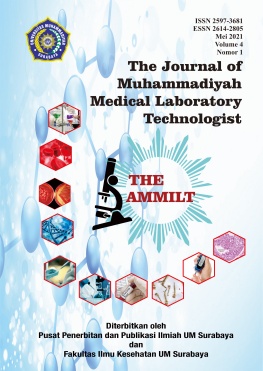Isi Artikel Utama
Abstrak
Hydroquinon is a chemical used as a skin lightener. However, its effectiveness began to be questioned after the emergence of a study showing that hydroquinone can trigger cancer. This study aims to analyze the hydroquinone content of several doctor-made creams and branded facial lightening creams circulating in Denpasar. This research is an experimental research. The sample used consisted of five samples of doctor-made creams coded D1-D5, while branded lightening creams were coded P1-P10. Based on the results of the analysis, the wavelength of 293 nm is the wavelength that provides maximum absorption with the equation y = 0.023x + 0.005 with a value of R2 = 0.996. 0.023. The results of the analysis showed that all samples of the doctor's cream contained hydroquinone with an average of 11.9322 ppm or 1.1932% and did not exceed the BPOM regulations, namely 5% for cream preparations prescribed by doctors. And all samples of branded facial lightening creams in Denpasar City contain hydroquinone with an average hydroquinone level of 3,987 ppm or 0.3987% and do not exceed the BPOM regulations, which is 2% for whitening cream preparations that are sold freely without a doctor's prescription.
Â
Rincian Artikel
Referensi
- Anief, Mohammad, 2009, Prinsip Umum dan Dasar Farmakologi, Yogyakarta: Gajah Mada University Press.
- Asih, S. B., 2006, Dampak Pengguna Kosmetika Pemutih terhadap Kesehatan Kulit pada Ibu-ibu di RW II Desa Limpung Kecamatan Limpung Kabupaten Batang Jawa, Skripsi, Fakultas Teknik, Universitas Negeri Semarang.
- Baran, L, 2008, Textbook of Cosmetic Dermatology, 2ed., London : Martin Dunits Ltd.
- BPOM RI, 2007, Kosmetika Mengandung Bahan Berbahaya dan Zat Warna yang Dilarang : Keputusan Kepala BPOM No. HK.00.01.03.1.23.08.11.07517.
- Departemen Kesehatan RI, 2005, Farmakope Indonesia, Edisi Keempat, Direktorat jendral Pengawasan Obat dan Makanan, Depkes RI.
- Dorland, 2002, Kamus Saku Kedokteran Dorlan edisi 29. Jakarta: Buku Kedokteran EGC.
- Draelos and Zoe Diana, 2005. Cosmeceuticals, USA : Elseiver.
- Gandjar., I. G., dan Rohman, A., 2007, Kimia Farmasi Analisis, Yogyakarta: Pustaka Pelajar.
- Ibrahim Slamet, 2004, Penetapan Kecermatan dan Keseksamaan Metode Kolorimetri Menggunakan Pereaksi Floroglusin Untuk Penetapan kadar Hidrokuinon dalam Krim Pemucatan, ITB : Bandung.
- Irnawati, Sahumena, M.H., dan Dewi, W. O., 2016, Analisis Hidrokuinon pada Krim Pemutih Wajah dengan Menggunakan Spektrofotometri UV-Vis. Jurnal Ilmiah Farmasi UNSRAT: Pharmacon. 5 (3): 2302-2493.
- Miller, J. N., dan Miller J. C., 2010, Statistics And Chemometries For Analytical Chemistry. Sixth Edition. England: Pearson Education.
- Pedro Lopez Garcia, 2007, Determination of Optimum Wavelength and Derivative Order Inspectrophotometry for Quantitation of Hydroquinone in Krim, Revista Brasileira De Ciencias Farmaceuticasbrazilian Journal of Pharmaceutical Sciences.
- Saito, E, 1994, Detection of Hydroquinone in a poisoning Case, Journal of Forensic Science, JFSCA, Vol 39, No. 1, Januari 1994, Pp.266-270.
- Siddique, and Saima, 2012. Qualitative and Quantitative Estimation of Hydroquinone in Skin Whitening Cosmetics, Dermatological Science and Application, 2012, 2, 224-228 Doi: 10.4236.
- Sunarko, Th dan Riana M. 2007. Analisis Unsur-unsur Toksik dalam Sampel Krim Pemutih Wajah dengan Metode Analisis Aktivasi Neutron. Jurnal Penelitian Pusat Teknologi Bahan Industri Nuklir (BTBIN). Tangerang.
- Wasitaatmadja S. M. 2007, Penuntun Ilmu Kosmetik Medik. UI-Press. Jakarta.
Referensi
Anief, Mohammad, 2009, Prinsip Umum dan Dasar Farmakologi, Yogyakarta: Gajah Mada University Press.
Asih, S. B., 2006, Dampak Pengguna Kosmetika Pemutih terhadap Kesehatan Kulit pada Ibu-ibu di RW II Desa Limpung Kecamatan Limpung Kabupaten Batang Jawa, Skripsi, Fakultas Teknik, Universitas Negeri Semarang.
Baran, L, 2008, Textbook of Cosmetic Dermatology, 2ed., London : Martin Dunits Ltd.
BPOM RI, 2007, Kosmetika Mengandung Bahan Berbahaya dan Zat Warna yang Dilarang : Keputusan Kepala BPOM No. HK.00.01.03.1.23.08.11.07517.
Departemen Kesehatan RI, 2005, Farmakope Indonesia, Edisi Keempat, Direktorat jendral Pengawasan Obat dan Makanan, Depkes RI.
Dorland, 2002, Kamus Saku Kedokteran Dorlan edisi 29. Jakarta: Buku Kedokteran EGC.
Draelos and Zoe Diana, 2005. Cosmeceuticals, USA : Elseiver.
Gandjar., I. G., dan Rohman, A., 2007, Kimia Farmasi Analisis, Yogyakarta: Pustaka Pelajar.
Ibrahim Slamet, 2004, Penetapan Kecermatan dan Keseksamaan Metode Kolorimetri Menggunakan Pereaksi Floroglusin Untuk Penetapan kadar Hidrokuinon dalam Krim Pemucatan, ITB : Bandung.
Irnawati, Sahumena, M.H., dan Dewi, W. O., 2016, Analisis Hidrokuinon pada Krim Pemutih Wajah dengan Menggunakan Spektrofotometri UV-Vis. Jurnal Ilmiah Farmasi UNSRAT: Pharmacon. 5 (3): 2302-2493.
Miller, J. N., dan Miller J. C., 2010, Statistics And Chemometries For Analytical Chemistry. Sixth Edition. England: Pearson Education.
Pedro Lopez Garcia, 2007, Determination of Optimum Wavelength and Derivative Order Inspectrophotometry for Quantitation of Hydroquinone in Krim, Revista Brasileira De Ciencias Farmaceuticasbrazilian Journal of Pharmaceutical Sciences.
Saito, E, 1994, Detection of Hydroquinone in a poisoning Case, Journal of Forensic Science, JFSCA, Vol 39, No. 1, Januari 1994, Pp.266-270.
Siddique, and Saima, 2012. Qualitative and Quantitative Estimation of Hydroquinone in Skin Whitening Cosmetics, Dermatological Science and Application, 2012, 2, 224-228 Doi: 10.4236.
Sunarko, Th dan Riana M. 2007. Analisis Unsur-unsur Toksik dalam Sampel Krim Pemutih Wajah dengan Metode Analisis Aktivasi Neutron. Jurnal Penelitian Pusat Teknologi Bahan Industri Nuklir (BTBIN). Tangerang.
Wasitaatmadja S. M. 2007, Penuntun Ilmu Kosmetik Medik. UI-Press. Jakarta.

